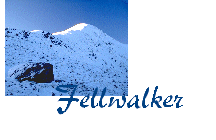

Weather and season
In my opinion changeable or stormy weather gives some of the best chances of a good photo and the warm low light of dawn and dusk the best time of day. In fact photographer Freeman Patterson says that "edges" often give the best photographs, whether of the land, the weather or the day. All seasons can give good opportunities but high summer is the least promising. For trees and leaves the fresh greens of spring before the leaves darken and the spectacular colours of autumn are often best. Mountain environments often look better once the bracken has changed to red and grass to yellow.
 Clarity will be best after rain or when airflows bring cold dry
unpolluted
air. The
light is everything !
Clarity will be best after rain or when airflows bring cold dry
unpolluted
air. The
light is everything !Wide angle lens
Wide
angle
allows two things, a wide view to include a strong foreground and deep
depth of field to enable foreground and background to be in focus.![]()
![]() To obtain maximum depth of field use the smallest aperture possible.
(By
setting the infinity marking on the focus ring to the depth of field
marker
for the aperture being used, the maximum depth of field that includes
infinity
will be obtained, the hyperfocal point).
To obtain maximum depth of field use the smallest aperture possible.
(By
setting the infinity marking on the focus ring to the depth of field
marker
for the aperture being used, the maximum depth of field that includes
infinity
will be obtained, the hyperfocal point).
Telephoto or
"long" lens
In
landscape
the function of a long lens is not only to bring things closer but
rather
to eliminate depth and compress distant objects into a closer
relationship
with foreground objects.![]()
 Taken to extremes
this can result in an almost abstract image
Taken to extremes
this can result in an almost abstract image ![]() .Its
shallow depth of field can be used to isolate one object in a complex
picture.
.Its
shallow depth of field can be used to isolate one object in a complex
picture.![]()
People
Inclusion
of figures in a landscape is a personal thing, I rarely include them
but
they can be used as a focal point or to emphasis the scale of a
landscape
and a sense of isolation ![]() or
to encourage an emotional response in the viewer.
or
to encourage an emotional response in the viewer.
Repetitions and
patterns
It is
worth
looking for repetitions that can be emphasised in an image, often with
a telephoto lens.![]()
![]()
Leading into
the picture
It
can be
helpful if a path or ridge can be found to lead the eye into the centre
of the picture.![]()
Sky and horizon
-rule
of thirds
The
classic
position for the horizon is probably a third way down the picture. I
would
urge you to abandon this approach and include sky based upon its
interest. ![]()
 Plain
blue (or even worse) grey skies being excluded.
Plain
blue (or even worse) grey skies being excluded.
However
the rule of thirds has its place in positioning objects within the
frame,
although always be ready to abandon it.
A philosophy
The
camera
must become an extension of your body, with its controls manipulated
instinctively
and intuitively. Your consciousness becomes its consciousness. The art
lies in communicating your soul though the fall of light in a
suspended
instant of time, look for those moments at the edges, of day and night,
land and sea, forest and plain, city and country, life and death. Look
for the deep song of the visual world. For the duende.
Search also in the details, in the detritus of a tideline, in the
crystal
of a snowflake and in the emptiness where less is more and perfection
is
obtained when nothing else can be removed.
And
remember
the lens cap!
Cameras &
equipment
Camera
features
are not very important. Any 35mm or better format that allows manual
control
of exposure and focus is suitable. For mountain photography light
weight,
ruggedness and minimum reliance on battery power are further
considerations.
A
built in
or independent light meter is essential and a tripod is useful,
especially
when taking long exposures to emphasise movement. ![]() (
(![]() again)
again)
Unlike
camera
features lens quality is of course important : I used to carry 17mm,![]() 24-50mm zoom
24-50mm zoom ![]() and
a 70-200mm zoom.
and
a 70-200mm zoom. ![]() Polorising
filters and lens hoods. I used to use 50 ASA Fujichrome film and scan
my
slides with a Nikon Coolscan V. I now use a 15 megapixel digital (APS).
Polorising
filters and lens hoods. I used to use 50 ASA Fujichrome film and scan
my
slides with a Nikon Coolscan V. I now use a 15 megapixel digital (APS).
My
digital
lens setup is 12-24, 24-70, 70-300 (plus 170-500 if wildlife potential)
and 70mm macro
to get about the same effects from a partial frame body as the film
camera.
(The 12-24 cannot accept a polariser). It is however much bulkier than
the film setup, although part of that is not due to digital issues.
Dont
forget Amazon UK when looking for photographic equpment (for SLR
lenses,
specify mount in search)
 Sigma
12-24 wide angle (Nikon fit), an ideal zoom range for digital
landscape
Sigma
12-24 wide angle (Nikon fit), an ideal zoom range for digital
landscape
Landscape
photography books & photographic software
Photographers rights